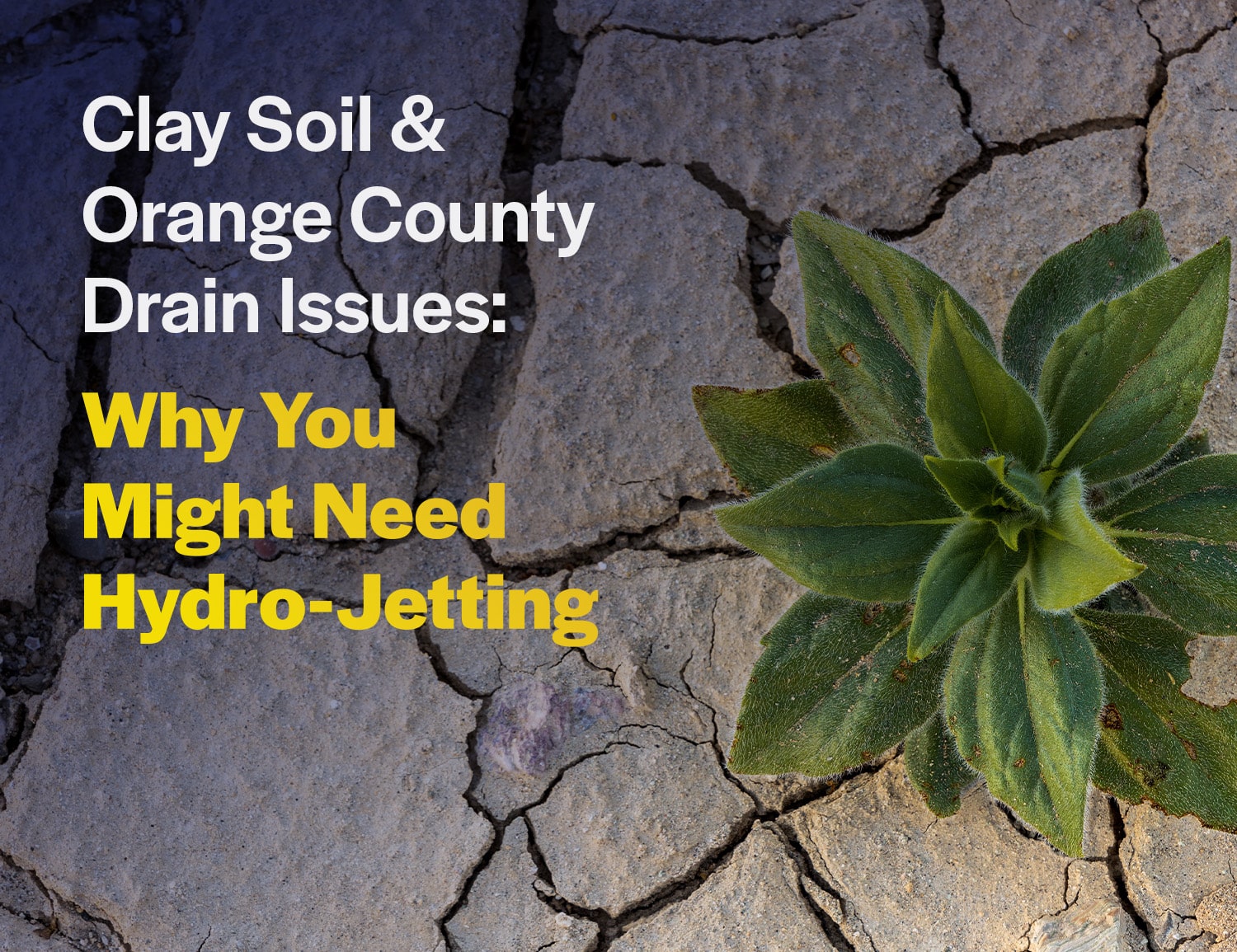
Orange County’s landscape is as diverse as its communities—from the coastal sands of Huntington Beach to the compact clay soils of inland neighborhoods like Tustin, Yorba Linda, and Mission Viejo. While the region’s natural beauty is undeniable, its unique soil composition can spell trouble for homeowners—especially when it comes to drainage and plumbing.
If you’ve ever wondered why your drains clog more often than your neighbor’s, or why certain areas in your yard seem to drain poorly after irrigation, the answer may lie beneath your feet. The culprit? Clay soil. And in Orange County, clay-heavy ground can quietly wreak havoc on plumbing systems—making hydro-jetting one of the most powerful solutions for long-term drain health.
Understanding Orange County’s Clay Soil
A large portion of Orange County is built on expansive clay soil, particularly in inland and suburban areas. Unlike sandy soils, which allow water to pass through easily, clay soils are composed of fine particles that compact tightly and retain moisture.
This dense nature makes clay soil excellent for holding nutrients—great for gardening, but problematic for plumbing. When the ground around your home is clay-heavy, it can trap moisture, restrict water flow, and create pressure around buried pipes. Over time, this environment can cause a variety of drainage issues, including:
- Slow-moving drains
- Frequent clogs
- Sewer line backups
- Root intrusion
- Pipe corrosion or misalignment
In short, clay soil doesn’t just affect your landscaping—it can directly impact your home’s underground plumbing system.
How Clay Soil Contributes to Drain Problems
1. Soil Compaction and Pipe Pressure
Clay’s dense texture makes it prone to compaction, especially under heavy irrigation or foot traffic. As the soil compresses, it can shift pipes, squeeze joints, and create misalignments in your drainage system. Even slight movement can cause debris buildup or small cracks that grow over time.
2. Water Retention and Standing Moisture
Clay retains water like a sponge. After irrigation or rain, that moisture doesn’t drain quickly—it lingers. The result? Constant dampness around pipes that accelerates corrosion and rusting, particularly in older metal systems.
3. Root Attraction
Tree and shrub roots are naturally drawn to the moisture-rich environment that clay soil creates. They often invade small openings in sewer lines searching for water, expanding inside the pipes and forming stubborn clogs that regular snaking can’t clear.
4. Sediment Buildup
Because clay particles are so fine, they can enter drainage systems through minor cracks or joints. Over time, these particles collect inside pipes—mixing with grease, soap scum, and organic debris to create thick, sticky blockages.
Why Traditional Drain Cleaning Often Fails
When a clog forms in a home with clay soil surroundings, many homeowners try standard solutions first: chemical drain cleaners, plungers, or cable snaking. Unfortunately, these quick fixes often don’t address the root cause.
Cable snaking can punch a temporary hole through a blockage but doesn’t remove the buildup coating the pipe walls. Chemical cleaners can damage your pipes and are largely ineffective against compacted clay sediment or root infiltration.
That’s why for properties affected by Orange County’s clay-rich ground, hydro-jetting stands out as a far more effective and lasting solution.
What Is Hydro-Jetting?
Hydro-jetting is a professional drain-cleaning method that uses high-pressure water streams (up to 4000 PSI) to blast away debris, grease, mineral deposits, and even invasive roots inside pipes. Unlike traditional mechanical methods, hydro-jetting completely scours pipe interiors, restoring them to near-original capacity without the need for harsh chemicals or invasive digging.
A specialized nozzle is inserted into your drain line and guided through the system. As the high-pressure water jets spin and spray in multiple directions, they break up hardened buildup, flush it out, and smooth the interior walls of the pipe—helping prevent future blockages.
Why Hydro-Jetting Works Best in Clay Soil Conditions
1. Removes Compact Sediment
Clay soil deposits are dense and sticky. A hydro-jet’s pressure is powerful enough to dislodge these fine particles, flush them completely out, and prevent them from reforming downstream.
2. Breaks Through Root Intrusions
Tree roots are a major problem in clay-heavy areas where moisture retention is high. Hydro-jetting can cut through small to medium root masses, clearing the line without needing excavation.
3. Restores Flow Without Pipe Damage
Unlike harsh chemical treatments or abrasive cable methods, hydro-jetting cleans with pure water—meaning it’s safe for both PVC and older metal pipes when performed by a licensed technician.
4. Prevents Future Clogs
Because hydro-jetting removes residue buildup and smooths pipe walls, future debris is less likely to stick. This makes it a proactive maintenance solution, not just a reactive one.
When to Consider Hydro-Jetting
If you live in an area of Orange County with known clay soil and are experiencing any of the following, hydro-jetting is worth considering:
- Frequent drain backups or slow drains
- Gurgling noises from toilets or sinks
- Unpleasant drain odors
- Visible tree roots near sewer lines
- Standing water in the yard or slow-draining irrigation systems
Homeowners often choose to hydro-jet their lines every 1–2 years as part of preventive maintenance, especially if the property has older pipes or mature landscaping.
The Environmental Advantage
Hydro-jetting aligns with Orange County’s growing focus on eco-friendly maintenance. Because it uses only water, it’s safe for both your plumbing and the local environment—unlike chemical drain cleaners that can leach toxins into the soil and groundwater.
By using hydro-jetting, you’re choosing a solution that’s both powerful and sustainable, protecting your home and community’s environment.
Professional Insight: Why DIY Isn’t Enough
Hydro-jetting equipment requires professional training and safety precautions. Incorrect use can damage pipes or push debris into joints instead of clearing them. That’s why Orange County homeowners trust licensed plumbing experts like VIP Sewer and Drain Services—who use advanced camera inspections to locate problem areas before and after jetting.
This diagnostic step ensures precision cleaning, verifies that pipes are intact, and helps prevent future issues related to soil shifting or root regrowth.
Protecting Your Home from Clay Soil Drain Damage
Clay soil may be part of Orange County’s natural landscape, but that doesn’t mean it has to control your plumbing. With the right maintenance strategy—centered around professional hydro-jetting—you can protect your pipes from sediment buildup, root intrusion, and pressure damage for years to come.
Pro Tip: Pair hydro-jetting with annual video inspections and routine maintenance to catch early warning signs before they escalate into costly repairs.
Orange County’s clay soil is as challenging as it is common. While it may silently contribute to frequent drain issues, understanding its impact—and choosing modern solutions like hydro-jetting—can make all the difference.
If your home is showing signs of stubborn clogs or slow drainage, it may be time for a deeper clean. VIP Sewer and Drain Services offers expert hydro-jetting solutions designed specifically for Orange County’s soil and climate conditions.
Contact us today to schedule an inspection and give your drains the long-lasting relief they deserve.


